-
Countries
-
Data and Analysis
-
Special Focus
-
Crisis Responses
Event Tracking

Contact
DTM Chad, dtmtchad@iom.int
Language
English
Location
Chad
Period Covered
Jun 18 2024
Jun 18 2024
Activity
- Mobility Tracking
- Event Tracking
Over 780,000 people have crossed into Chad since the onset of the crisis in Sudan. IOM estimates that 201,379 among them are Chadian returnees and expects this number to rise to 240,000 through to December 2024. This is due to ongoing conflict and food insecurity in Darfur, owing to the current suspension of the humanitarian corridor between Chad and Darfur.
Returnees are Chadian nationals who were living in Sudan and have been displaced back to their home country where they lack the resources to rebuild their lives. Returnees are living either in displacement sites or within host communities. They are in urgent need of food, water, sanitation and hygiene shelter, household items, health, and protection. IOM is the lead agency for the returnee response, in close coordination with the Government of Chad, local authorities, UN agencies, and local and international NGOs.
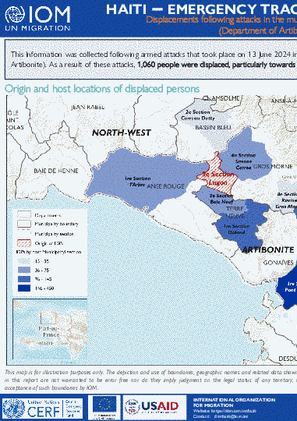
Contact
dtmhaiti@iom.int
Language
English
Location
Haiti
Period Covered
Jun 14 2024
Jun 17 2024
Activity
- Mobility Tracking
- Event Tracking
This Information was collected following armed attacks that took place on 13 June 2024 in the municipality section of Lagon located in the municipality of Terre Neuve (Department of Artibonite). As a result of these attacks, 1,060 people were displaced, particularly towards the municipality of Gonaïves (68%). All of these people took refuge with host families.
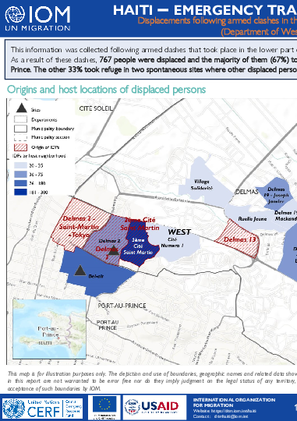
Contact
dtmhaiti@iom.int
Language
English
Location
Haiti
Period Covered
Jun 14 2024
Jun 15 2024
Activity
- Mobility Tracking
- Event Tracking
This information was collected following armed clashes that took place in the lower part of the municipality of Delmas in the Metropolitan Area of Port-au-Prince, since 13 June 2024.
As a result of these clashes, 767 people were displaced and the majority of them (67%) took refuge with host families in neighborhoods in the same municipality and in that of Port-au-Prince. The other 33% took refuge in two spontaneous sites where other displaced persons have been residing for several months. Updates will be published by DTM according to the
evolution of displacements.

Contact
DTM Support — iomdrcdtm@iom.int
Language
French
Location
Democratic Republic of the Congo
Period Covered
Jun 04 2024
Jun 09 2024
Activity
- Mobility Tracking
- Event Tracking
Depuis le 27 mai 2024, des violents combats entre les FARDC et le groupe M23 et leurs alliés dans le territoire de Rutshuru se sont rapprochés de l’agglomération de Kanyabayonga, situé à cheval des territoires de Lubero et Rutshuru. Des populations hôtes de villages de la zone de santé de Kibirizi en groupement de Kanyabayonga (villages de Lusuli Bulindi, Lusogha, Burindule, et Butalongola) dans le territoire de Rutshuru et ceux des communes rurales de Kanyabayonga et Bulotwa (territoire de Lubero) ainsi que les personnes déplacées déjà reçues dans les zones affectées ont été contraint de se déplacer vers les zones considérées comme relativement sécure. Ces zones de refuge se trouvent territoire de Lubero dans les zones de santé de Kayna, Alimbongo, et Butembo; et dans le territoire de Walikale dans la zone de santé de Pinga (groupement d’Ikobo). Ces ménages déplacés ont été reçus en majorité dans les familles d’accueil ainsi que dans les centres collectifs. Les besoins humanitaires sont considérables dans l'ensemble des zones touchées et risquent de s'aggraver encore sans une action urgente.

Contact
IraqDTM@iom.int
Language
English
Location
Iraq
Period Covered
Mar 01 2024
Mar 15 2024
Activity
- Mobility Tracking
- Event Tracking
يقيس تقرير تتبع حالات الطوارئ المناخية هذا (الترجمة العربية) النزوح الناجم عن المناخ في جميع أنحاء وسط وجنوب العراق. العائلات المشمولة في تقارير تتبع حالات الطوارئ هذه هي تلك التي أُجبرت على الانتقال من مواقعها بسبب الجفاف وندرة المياه والتدهور البيئي وعوامل مناخية أخرى.
وحتى 15 مارس/آذار 2024، لا تزال 23,364 عائلة (140,184 فرداً) نازحة بسبب العوامل المناخية في 12 محافظة. وتنتشر الأسر النازحة في 497 موقعًا. من بين هذه الأسر، أقل بقليل من نصف الأسر النازحة داخل منطقتهم الأصلية (47%). أكثر بقليل من نصف الأسر النازحة إلى مواقع حضرية.
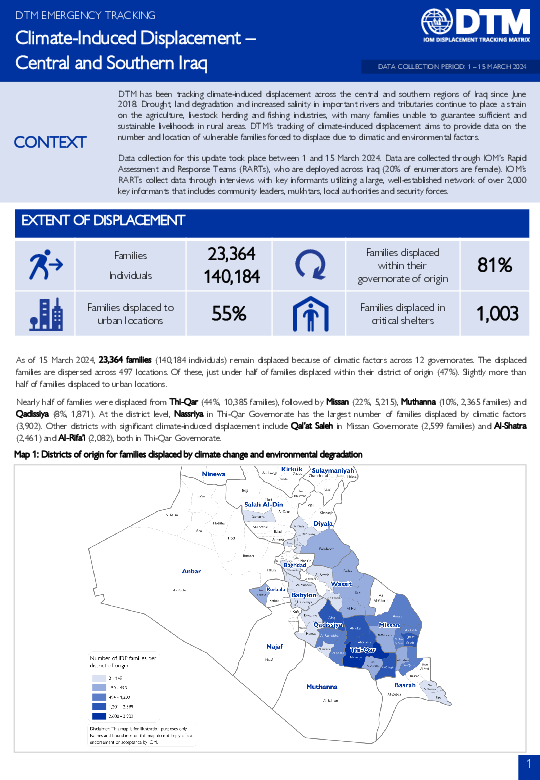
Contact
IraqDTM@iom.int
Language
English
Location
Iraq
Period Covered
Mar 01 2024
Mar 15 2024
Activity
- Mobility Tracking
- Event Tracking
This Climate Emergency Tracking Report measures climate-induced displacement across central and southern Iraq. Families included in these Emergency Tracking reports are those forced to move locations due to drought, water scarcity, environmental degradation and other climatic factors.
As of 15 March 2024, 23,364 families (140,184 individuals) remain displaced because of climatic factors across 12 governorates. The displaced families are dispersed across 497 locations. Of these, just under half of families displaced within their district of origin (47%). Slightly more than half of families displaced to urban locations.
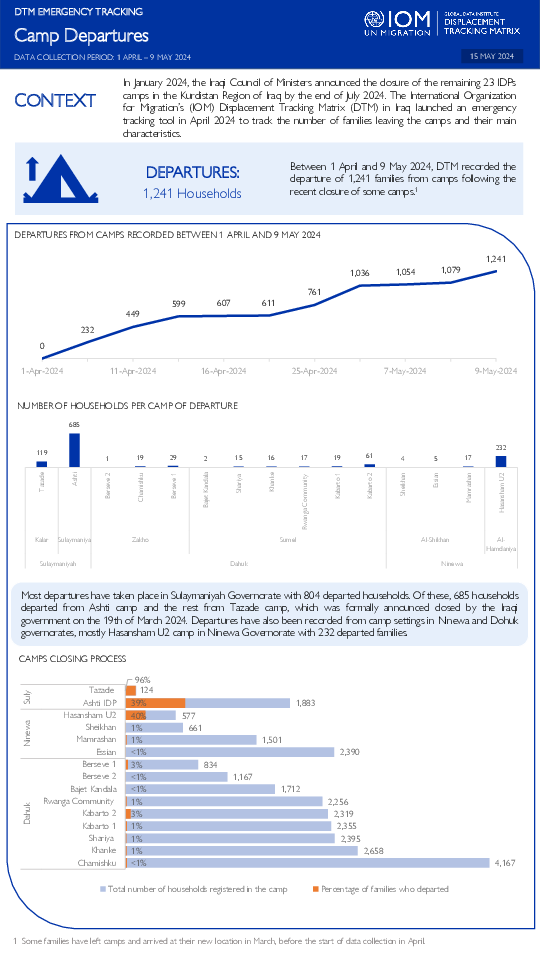
Contact
IraqDTM@iom.int
Language
English
Location
Iraq
Period Covered
Apr 01 2024
May 09 2024
Activity
- Mobility Tracking
- Event Tracking
In January 2024, the Iraqi Council of Ministers announced the closure of the remaining 23 IDPs camps in the Kurdistan Region of Iraq by the end of July 2024. The International Organization for Migration’s (IOM) Displacement Tracking Matrix (DTM) in Iraq launched an Emergency Tracking Tool on Camp departures in April 2024 to track the number of families leaving the camps and their main characteristics.
Between 1 April and 9 May 2024, DTM recorded the departure of 1,241 families from camps following the recent closure of some camps. As of 9 May 2024, DTM recorded the arrival of 993 families out of the total 1,241 departed from camps (80%). Most families arrived to Salah al-Din Governorate (68%) and Ninewa Governorate (30%).

Contact
DTM DRC, iomdrcdtm@iom.int
Language
English
Location
Democratic Republic of the Congo
Period Covered
Apr 30 2024
May 28 2024
Activity
- Mobility Tracking
- Event Tracking
The eastern part of the Democratic Republic of Congo (DRC), in particular North Kivu, is in the grip of an increasingly complex and persistent conflict. This conflict is characterized by the presence of various armed groups such as the M23 group, the Congolese Armed Forces (FARDC) and their respective allies. The expansion of the conflict during the first six months of 2023 has led to substantial displacement of civilians, a sharp increase in the presence of armed actors in North Kivu, the loss of human life and significant damage to infrastructure and property. The population of destabilized towns in the border region between the provinces of North and South Kivu has increased the number of displacements. Despite widespread calls for a peaceful resolution to the conflict from regional and international actors, joint efforts to facilitate dialogue and negotiate ceasefires have regularly been disrupted.
From 30 April to 28 May 2024, the context was characterized by an expansion of the fighting in North Kivu, with the use of heavy munitions causing significant damage and loss of life in the displacement sites around Goma and Minova in South Kivu province. All the areas affected are suffering from a lack of resources and economic opportunities, as well as insecurity caused by the proliferation of weapons. Clashes have continued both in areas already controlled by the M23 and in those controlled by the government and its allies leading to considerable disruption to daily life and a dangerous environment for local communities as well as the delivery of much needed humanitarian assistance in many areas.
The recent spontaneous clashes on several front lines have affected Masisi territory in the Mupfunyi-Shanga, Kamuronza, Bahali-Mokoto, Mupfunyi-Kibabi and Mupfunyi-Matanda groupements, the Osso-Banyungu sector, and Rutshuru territory in the Mutanda and Kanyabayonga groupements. The local population, displaced persons staying with host families and recent returnees have been forced to move again or to engage in pendular displacement.
Since the beginning of the crisis, IOM through the Displacement Tracking Matrix (DTM) continues to conduct a series of rapid assessments, including emergency event tracking (EET/ERM), crisis analysis and registration with a priority to respond to immediate information needs in order to understand displacement dynamics and needs.
This report presents the results of the assessments carried out in the various areas of displacement and return from 30 April to 28 May 2024.

Contact
DTM DRC, iomdrcdtm@iom.int
Language
French
Location
Democratic Republic of the Congo
Period Covered
Apr 30 2024
May 28 2024
Activity
- Mobility Tracking
- Event Tracking
La partie orientale de la République démocratique du Congo (RDC), en particulier au Nord-Kivu, est en proie à un conflit de plus en plus complexe et persistant. Ce conflit est caractérisé par la présence de divers groupes armés tels que le groupe M23, les Forces Armées Congolaises (FARDC) et leurs alliés respectifs. L'expansion des conflits pendant les six premiers mois de 2023 a entraîné un déplacement substantiel de civils, une forte augmentation de la présence des acteurs armés dans le Nord-Kivu et des dégâts humains et matériaux.
La population des agglomérations déstabilisées situées à cheval entre les provinces du Nord-Kivu et Sud-Kivu a augmenté le nombre de déplacements. Malgré les appels généralisés en faveur d’une résolution pacifique du conflit de la part des acteurs régionaux et internationaux, les efforts conjoints pour faciliter le dialogue et négocier des cessez-le-feu ont régulièrement été perturbés.
Du 30 avril au 28 mai 2024, le contexte a été caractérisé par une expansion des combats dans le Nord-Kivu, avec l'utilisation de munitions lourdes causant des dégâts significatifs et des pertes en vies humaines dans les sites de déplacement autour de Goma et Minova dans la province du Sud-Kivu. Toutes les zones touchées souffrent d'une pénurie de ressources et d'opportunités économiques, ainsi que de l'insécurité causée par la prolifération des armes. Les affrontements se sont poursuivis à la fois dans les zones déjà contrôlées par le groupe M23 et dans celles contrôlées par le gouvernement et ses alliés.
Les récents affrontements spontanés sur plusieurs lignes de front ont affecté le territoire de Masisi dans les groupements de Mupfunyi-Shanga, Kamuronza, Bahali-Mokoto, Mupfunyi-Kibabi, et Mupfunyi-Matanda, le secteur d'Osso-Banyungu, et le territoire de Rutshuru dans les groupements de Mutanda et Kanyabayonga. Les populations locales, les personnes déplacées accueillies dans des familles d'accueil et les personnes récemment retournées ont été contraintes de se déplacer à nouveau ou d'effectuer des mouvements pendulaires.
Depuis le début de la crise, l’OIM par le biais de la matrice de suivi des déplacements (DTM) continue à mener une série d'évaluations rapides, y compris le suivi des urgences (EET/ERM), l'analyse des crises et enregistrement avec priorité de répondre aux besoins immédiats d'information en vue de comprendre la dynamique des déplacements et les besoins.
Ce rapport présente les résultats des évaluations menées dans les différentes zones de déplacement et de retour du 30 avril au 28 mai 2024
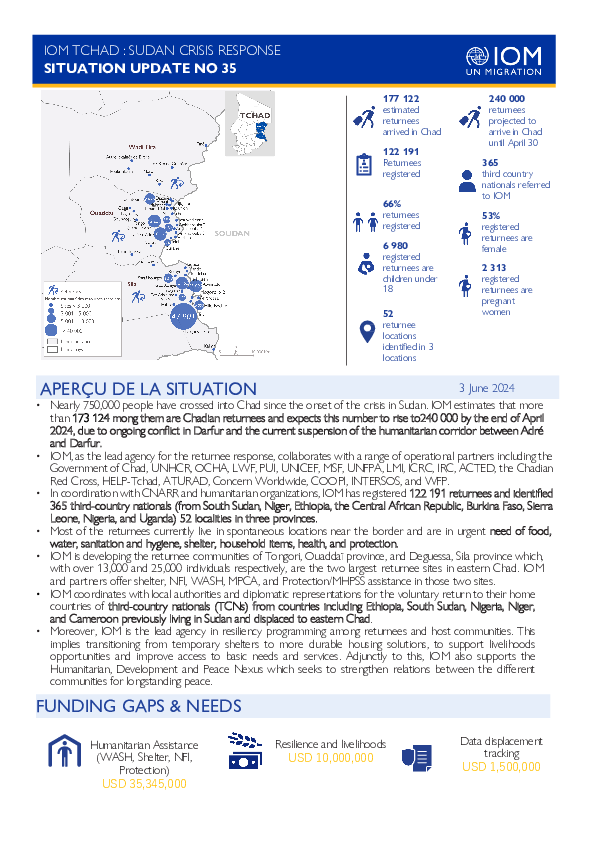
Contact
DTM Chad, dtmtchad@iom.int
Language
English
Location
Chad
Snapshot Date
Jun 03 2024
Activity
- Mobility Tracking
- Event Tracking
• Nearly 750,000 people have crossed into Chad since the onset of the crisis in Sudan. IOM estimates that more than 173 124 mong them are Chadian returnees and expects this number to rise to240 000 by the end of April 2024, due to ongoing conflict in Darfur and the current suspension of the humanitarian corridor between Adré and Darfur.
• IOM, as the lead agency for the returnee response, collaborates with a range of operational partners including the Government of Chad, UNHCR, OCHA, LWF, PUI, UNICEF, MSF, UNFPA, LMI, ICRC, IRC, ACTED, the Chadian Red Cross, HELP-Tchad, ATURAD, Concern Worldwide, COOPI, INTERSOS, and WFP.
• In coordination with CNARR and humanitarian organizations, IOM has registered 122 191 returnees and identified 365 third-country nationals (from South Sudan, Niger, Ethiopia, the Central African Republic, Burkina Faso, Sierra Leone, Nigeria, and Uganda) 52 localities in three provinces.
• Most of the returnees currently live in spontaneous locations near the border and are in urgent need of food, water, sanitation and hygiene, shelter, household items, health, and protection.
• IOM is developing the returnee communities of Tongori, Ouaddaï province, and Deguessa, Sila province which, with over 13,000 and 25,000 individuals respectively, are the two largest returnee sites in eastern Chad. IOM and partners offer shelter, NFI, WASH, MPCA, and Protection/MHPSS assistance in those two sites.
• IOM coordinates with local authorities and diplomatic representations for the voluntary return to their home countries of third-country nationals (TCNs) from countries including Ethiopia, South Sudan, Nigeria, Niger, and Cameroon previously living in Sudan and displaced to eastern Chad.
• Moreover, IOM is the lead agency in resiliency programming among returnees and host communities. This implies transitioning from temporary shelters to more durable housing solutions, to support livelihoods opportunities and improve access to basic needs and services. Adjunctly to this, IOM also supports the Humanitarian, Development and Peace Nexus which seeks to strengthen relations between the different communities for longstanding peace.
Pagination
- Previous page
- Page 27
- Next page
